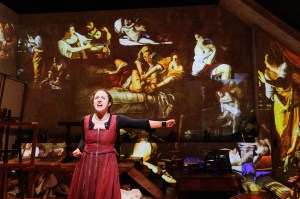
and Molly Ranson in The Burnt Part Boys
(© Joan Marcus)
The potential for the new musical The Burnt Part Boys, now being presented at Playwrights Horizons (in a co-production with the Vineyard Theatre), to sear into theatergoers’ hearts is staggering. So it’s sad to report that the tuner is merely a quaintly wan echo of familiar and more successful coming-of-age stories.
Set in West Virginia in 1962, the show centers on a group of young people whose fathers died in a coal mining accident 10 years prior to the start of the action. Given recent headlines from the region about similar events and loss of life, one would naturally assume that the musical would resonate intensely today — perhaps even more so than bookwriter Mariana Elder, lyricist Nathan Tysen and composer Chris Miller might have intended or imagined. In the end, that’s simply not the case.
At the center of the piece is 14-year-old Pete (a winsome, but periodically strained, Al Calderon), a plucky kid whose worldview has been shaped not by his long-dead father, but rather by the heroes he’s seen at the movies, particularly his favorite, The Alamo. When he learns that the mine in which his father died (and where the man’s remains still lie) is about to be reopened, Pete takes it upon himself to ensure that no one will be put in danger there again by taking dynamite from a lockbox his miner brother Jake (imbued with brooding intensity and bitterness by Charlie Brady) has brought home.
Pete sets off on the mission, accompanied by his nerdy best friend Dusty (played with sure-handed aplomb by Noah Galvin), the only one of the young characters who’s been lucky enough to grow up with a father, but soon enough, Jake and his dim pal Chet (played winningly by Andrew Durand) are in pursuit. As if being stopped by his brother were not enough to worry about, Pete also has to contend with adding the contentious and cantankerous tomboy Frances (played like a pubescent Annie Oakley by Molly Ranson) as part of his posse.
After establishing the principal characters’ backstories and their defining characteristics, Elder never allows them to evolve, and Tysen and Miller share fault in this lack of progression to the piece by rarely providing any character numbers. Instead, the twangy tunes are merely a succession of numbers that provide color and atmosphere rather than substance.
There are two theatrical conceits that do spark the show occasionally to life. The ghosts of the miners who were killed in the accident, including Pete and Jake’s dad (Michael Park), have a presence in the piece, and while one’s never entirely sure of their purpose, it ultimately becomes clear that it’s both metaphysical and dramaturgical. Equally intriguing are appearances by Pete’s movie heroes (all played with panache by Park), who offer advice and guidance in times of need.
Joe Calarco’s fussy direction, which has the actors rearranging several ladders and chairs to indicate obstacles (the spare scenic design is by Brian Prather) and traipsing through the aisles among theatergoers, never energizes the piece. Worse yet, it often gives the piece a curiously numbing circularity. Lindsay Jones’ sound design — which makes the actors’ voices sound as if they’ve been piped in, along with the off-stage band — only serves to distance the audience further from this disappointing musical.









